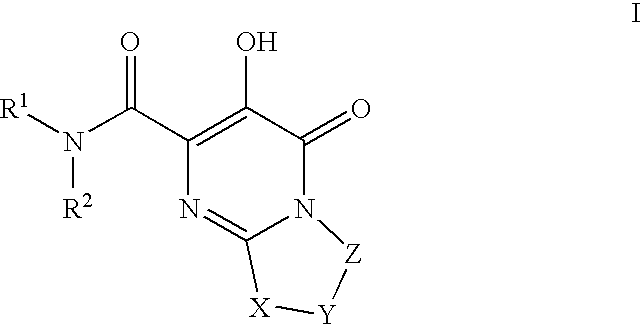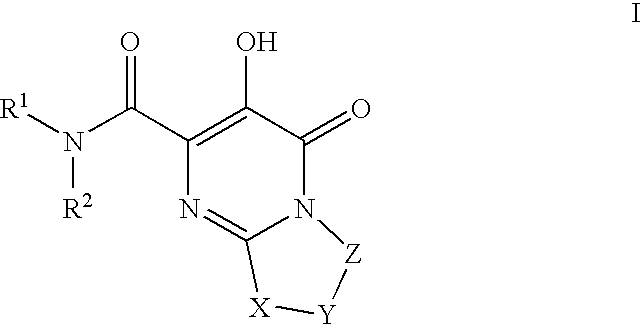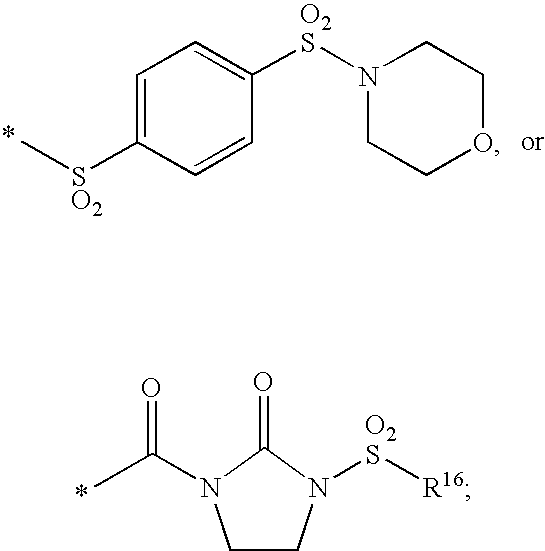HIV integrase inhibitors
a technology of integrase inhibitors and hives, which is applied in the field of compounds, can solve the problems of large number of patients who fail to respond to this therapy, and not all patients are responsiv
- Summary
- Abstract
- Description
- Claims
- Application Information
AI Technical Summary
Benefits of technology
Problems solved by technology
Method used
Image
Examples
example 1
[0569]
[0570]7,11-Epoxy-4H-pyrimido[1,2-a]azocine-2-carboxamide, N-[(4-fluorophenyl)methyl]-6,7,8,9,10,11-hexahydro-3-hydroxy-4-oxo-, (7S,11R)—. To ethyl (7S,11R)-3-hydroxy-4-oxo-6,7,8,9,10,11-hexahydro-4H-7,11-epoxypyrimido[1,2-a]azocine-2-carboxylate (0.050 mg, 0.18 mmol) in EtOH (10 mL) was added 4-fluorobenzylamine (0.081 g, 0.71 mmol). The reaction mixture was stirred at reflux for 4 hours in a sealed tube. The solvent was removed in vacuo and the product purified by preparative HPLC (C18 column) to afford 0.029 g (45% yield) of the title compound. 1H NMR (400 MHz, CDCl3) δ ppm 12.05 (1 H, s), 7.86 (1 H, m), 7.31-7.38 (2 H, m), 7.04-7.16 (2 H, m), 4.77 (1 H, d, J=2.3 Hz), 4.53-4.65 (3 H, m), 4.01-4.10 (2 H, m), 2.03-2.14 (2 H, m), 1.85 (1 H, dd, J=13.6, 1.8 Hz), 1.76 (2 H, d, J=2.0 Hz), 1.31-1.43 (1 H, m).). LCMS (+ESI, M+H+) m / z 360. HRMS (ESI+) calculated for C13H16N2O5 [M+H+]:360.1360; found: 360.1351.
example 2
[0571]
[0572]7,11-Epoxy-4H-pyrimido[1,2-a]azocine-2-carboxamide, N-[[4-fluoro-2-(1H-1,2,4-triazol-1-yl)phenyl]methyl]-6,7,8,9,10,11-hexahydro-3-hydroxy-4-oxo-, (7S,11R)—. To ethyl (7S,11R)-3-hydroxy-4-oxo-6,7,8,9,10,11-hexahydro-4H-7,11-epoxypyrimido[1,2-a]azocine-2-carboxylate (0.050, 0.18 mmol) in EtOH (5 mL) was added (4-fluoro-2-(1H-1,2,4-triazol-1-yl)phenyl)methanamine hydrochloride (0.081 mg, 0.36 mmol) and diisopropylethylamine (0.063 mL, 0.36 mmol). The reaction mixture was heated in a microwave oven at 160° C. for 3 h. LC-MS showed ˜50% conversion to the target compound. The reaction mixture was stirred at 160° C. for an additional 3 h. EtOH was removed in vacuo and the crude material was purified by preparative HPLC using a C18 column and trifluoroacetic acid in the mobile phase. Solvent from the purification was removed and CH3CN (5 mL) and H2O (1 mL) were added and the resulting solution frozen and lyophilized overnight (16 h) to afford 21 mg (28% yield) of the title comp...
example 3
[0573]
[0574]7,11-Epoxy-4H-pyrimido[1,2-a]azocine-2-carboxamide, N-[[4-fluoro-2-[(methylamino)carbonyl]phenyl]methyl]-6,7,8,9,10,11-hexahydro-3-hydroxy-4-oxo-, (7S,11R)—. 1H NMR (400 MHz, CDCl3) δ ppm 8.55 (1 H, s), 7.38-7.45 (1 H, m), 7.24-7.31 (2 H, m), 4.72 (1H, d, J=2.3 Hz), 4.47-4.54 (3 H, m), 3.83-3.98 (2 H, m), 2.78 (2 H, d, J=4.6 Hz), 1.89-1.99 (2 H, m), 1.73 (2 H, m), 1.49-1.54 (1 H, m), 1.34-1.17 (1 H, m). LCMS (+ESI, M+H+) m / z 417. HRMS (ESI+) calculated for C20H21FN4O5 [M+H+]: 417.1574; found: 417.1575.
PUM
 Login to View More
Login to View More Abstract
Description
Claims
Application Information
 Login to View More
Login to View More - R&D
- Intellectual Property
- Life Sciences
- Materials
- Tech Scout
- Unparalleled Data Quality
- Higher Quality Content
- 60% Fewer Hallucinations
Browse by: Latest US Patents, China's latest patents, Technical Efficacy Thesaurus, Application Domain, Technology Topic, Popular Technical Reports.
© 2025 PatSnap. All rights reserved.Legal|Privacy policy|Modern Slavery Act Transparency Statement|Sitemap|About US| Contact US: help@patsnap.com



